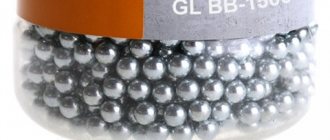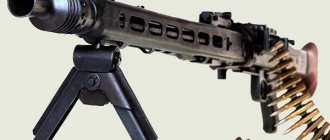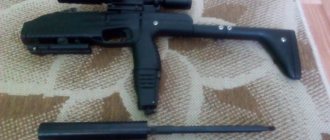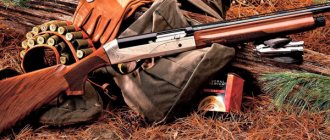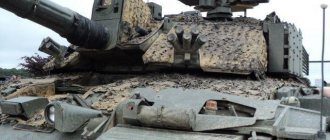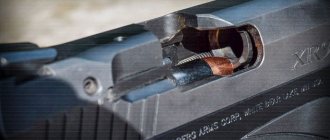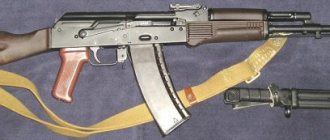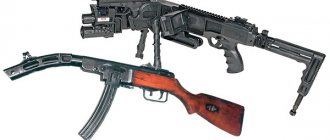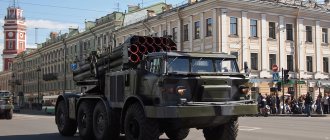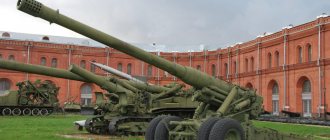Strength and "survivability" of trunks
When a charge burns in a weapon barrel, powder gases develop very high pressure. For example, in the muzzle of a barrel, even the smallest pressure during the departure of a bullet is equal to several hundred atmospheres.
Durability of hunting rifle barrels
In order for the barrel to withstand such stress, great attention is paid to the strength of the barrel during the manufacture of weapons. The very strength of the barrel always depends on the thickness of its walls, as well as on the quality of the metal.
The barrel of the weapon, according to the nature of the gas pressure curve, is made thicker at the breech and thinner at the muzzle.
The thickness of the barrel walls, taking into account the practical operation of the gun, is always calculated with such a margin of safety that it can withstand gas pressure much greater than normal. And therefore, the strength of the barrel always exceeds the normal pressure of powder gases (which is formed during firing with conventional cartridges) by several hundred, or even thousands of atmospheres.
At the moment of firing, resisting gas pressure, the walls of the barrel expand. And the strength of the barrel is calculated in such a way that the metal is subjected to only elastic expansion deformations. So that it expands under gas pressure, and after the pressure stops it takes on its original dimensions. If the pressure in the barrel exceeds the value for which the strength of the barrel is designed, permanent deformation will occur, the barrel will swell or even rupture.
Cases of rupture of rifle barrels in shooting practice are extremely rare; The probability of rupture of massive, thick barrels of arbitrary rifles is especially low. But swelling of the trunks is considered a fairly common occurrence. In the overwhelming majority, barrel swelling is a consequence of careless attitude, as well as illiterate use of the gun on the part of the hunter.
Usually the cause of the formation of bloat is foreign bodies that are in the bore of the barrel during a shot in the path of the bullet. For example, tow left after cleaning, a rag, pieces of the cartridge case, thick grease that has collected in a drop, a plug of dirt or snow. A foreign body is considered an obstacle, a brake, which leads to a certain slowdown in the movement of the bullet; elastic powder gases following the bullet, hitting the bottom of it, are repelled, creating a reverse wave. At the same time, the main mass continues to move towards the muzzle. And the collision of two waves of gases creates such a strong radial pressure, which far exceeds the safety margin of the barrel. As a result, such a sharp increase in pressure causes swelling and sometimes rupture of the barrel. The swelling of the trunk is easily detected during a careful examination of its channel. The swelling of the trunk looks like a shadow ring. Sometimes the swelling can be detected by touch when it appears outward as a ring bulge on the trunk.
To avoid bloat, you need to carefully wipe the bore of your gun and train yourself to look at it carefully before shooting.
Minor swelling of the barrel in the breech or in the middle does not have much effect on the accuracy of the fire. The barrel of a weapon is subject to severe wear during operation. This is facilitated by a number of reasons of a thermal, mechanical and chemical nature.
The bullet, while passing through the bore, due to high friction forces, rounds the edges of the rifling fields and abrades the inner walls of the bore. In addition, particles of powder gases moving at high speed hit the walls of the barrel bore with force, thereby causing so-called hardening on their surface.
This phenomenon consists in the fact that the entire surface of the barrel bore is covered with a thin crust with fragility developing in it. And the elastic deformation of the barrel expansion that occurs at the moment of the shot always leads to the appearance of small cracks on the inner surface of the metal. The high temperature of the powder gases, despite the short duration of action, contributes to the formation of such cracks. It causes (partial) melting of the barrel bore surface. And large local stresses appear in the heated layer of metal, which ultimately lead to the appearance and enlargement of such small cracks. The increased fragility of the metal layer and the presence of cracks on it lead to the fact that, when passing through the channel, the bullet produces metal chips precisely in the places of the cracks.
Also, carbon deposits that remain in the barrel bore after a shot contribute significantly to barrel wear. It represents the remains of the combustion of gunpowder and impact composition, as well as metal melted from a bullet or scraped from it, particles of the cartridge case torn off by gases, etc.
The salts present in soot have the ability to absorb moisture from the air, dissolve in it and form solutions, reacting with the metal, which lead to its corrosion (or rusting), the appearance of a rash in the bore, and then cavities. All these factors lead to a change in the surface of the channel (this entails an increase in its caliber, especially at the muzzle entrance), as a consequence, to a decrease in its strength. Also, an increase in caliber leads to a decrease in the initial speed of the bullet, and then to a deterioration in the weapon’s combat, or rather, to a loss of its ballistic qualities.
But deterioration in the accuracy of combat in rifled weapons occurs not only due to the destruction of the surface of the barrel bore, but also due to its wear. It has long been established by practice that during operation, barrels of good quality begin to sharply or gradually deteriorate the accuracy of the fire. First of all, the reasons are: tombakization of the barrels at the time of firing with jacket bullets, leading of the barrels during the firing of small-caliber cartridges, in other words, deposition on the margins, as well as in the corners of the rifling, metal, which, moreover, is layered unevenly, creating depressions and bumps. And since metal deposits occur differently in each barrel, each rifle begins to change its action differently. Small-caliber rifles especially dramatically change combat due to lead plating. Therefore, every hunter should study the nature and all the fighting features of his weapon, as well as establish in what mode it has the best combat, and periodically clean the barrel of lead.
Survivability of hunting rifle barrels
The suitability of the barrel for subsequent shooting is determined by its “survivability” - the ability to withstand a certain number of shots, after which it loses its ballistic qualities.
An increase in the “survivability” of the trunk is achieved by proper care of it, as well as careful treatment - proper and timely cleaning.
What is influx
As we have already said, influx or, in other words, growth is one of the defects of wood, or more precisely, defects in the shape of the trunk. This is usually its thickening in one or several places, accompanied by a random arrangement of wood fibers inside this thickening (the so-called curling). The density of the influx is harder and weighs more than healthy trunk wood.
The reasons for the appearance of swells on trees are not exactly known. Among the expected ones are mechanical damage and infection of the plant. There is also an opinion that the occurrence of growths on trees is genetically determined.
Sometimes growths on the trunk can be a sign of certain types of tree cancer. In this case, the growths are usually irregular in shape and are often accompanied by significant cracking of the trunk, right down to its base.
- Bacterial plant cancer: prevention is easier than cure
What is bacterial canker, what plants can it affect, and is there a treatment for this dangerous disease? We will give answers to these and other questions in the article.
Nicks
Characteristic defects that disrupt normal combat are nicks on the muzzle of the barrel as a result of careless handling of the weapon.
Rice. 77. Notches deep into the metal and into the bore:
If, as a result of the inspection, a nick deep into the metal is revealed that does not have protruding edges, then it is not removed, since it does not affect the weapon’s engagement (Fig. 77).
A nick with metal protruding into the barrel bore affects the shooting results, since the bullet will deviate in the opposite direction from the nick. Such a nick is removed by removing the minimum required layer of metal.
Defects in the chrome plating of the bore
Wear of the rifled bore occurs as a result of prolonged use, non-compliance with the fire regime, as well as untimely and poor-quality maintenance.
Modern small arms have chrome-plated bores, but there are examples of weapons with non-chrome-plated barrels: the SKS carbine made before 1951, Makarov and Stechkin pistols made before 1954, RPG-2 grenade launchers.
A grid of chrome coating in the form of intersecting cracks (Fig. 71,a), as a rule, is observed from the breech of the barrel, especially in machine-gun barrels. So, when firing from a machine gun SGM, SGMT, the reticle of the height appears after 500 shots.
Rice. 70. Metal reamer for removing powder deposits from the walls of gas outlet holes
Chromium chips (Fig. 71, b) appear in the bore of a machine gun barrel usually after 1500 shots or more, and the peak from the breech is observed after 2500 shots. The appearance of these barrel defects depends on compliance with the fire regime and the design of the weapon (barrel caliber and cartridge power). Thus, the fire grid in the barrel of a 14.5-mm KPV (KPVT) machine gun appears after 200-300 shots, and chrome chips in the form of shells can appear after 400-500 shots.
Rice. 71. Destruction of chrome coating (section increased 150 times):
a — height grid; b - chrome chips; in the midst
These defects within the survivability of the barrel do not affect the operation of the weapon, but are prerequisites for the appearance of rust and peeling of chrome.
Defects such as shells, traces of rust, burns, chips or peeling of chrome in the bore are allowed provided that the weapon is in normal use. The presence of the indicated defects in the chamber is permitted provided that the spent cartridge is vigorously removed by the bolt ejector.
Wear of the barrel bore along the margins, rounding or bevelling of the corners of the rifling fields are determined visually, and the amount of wear is controlled by the entry of a non-pass caliber (Fig. 72), which, as a rule, is marked K-2.
Rice. 72. Caliber for checking the diameter of the bore by field:
1—mark, characterizing the entry of the caliber from the muzzle of the barrel;
2 - risk characterizing the entry of the caliber from the breech of the barrel;
A - working caliber size
For SGM and SGMT machine guns, a barrel wear check is established by inserting a non-passing caliber from the breech of the barrel to a length of 120 mm. This check is aimed at rejecting a barrel with a significant increase in rifling in the breech.
Weapon operating experience shows that less significant wear from the muzzle of the barrel has a greater impact on the weapon's performance. Therefore, for the RP-46 machine gun, wear checks of the barrel bore are installed on both sides: from the muzzle - by 7.62 mm, from the breech - by 100 mm.
For most modern weapons, barrel wear is checked only from the muzzle. Thus, for 7.62 mm AK, AKM assault rifles, RPK, RPD light machine guns and SVD rifles (for wartime conditions), the insertion size of the K-2 caliber should not exceed 7.62 mm, for PK, PKT machine guns - no more than 10 mm, for the DShKM machine gun - no more than 12.7 mm.
If the entry of the non-passage K-2 caliber into the barrel bore does not exceed the specified values, then the barrel still has a small margin of survivability. Weapons with such wear on the barrel are allowed for further use provided that they meet the requirements for normal combat accuracy.
Thus, shooting plays a major role in assessing the condition of the barrel.
The criteria for assessing barrel survivability are:
— a drop in the initial velocity of the bullet to a certain value (tested in the laboratory of a factory or testing ground);
- increased bullet dispersion and the appearance of bullets breaking off the rifling.
According to the accuracy of the battle, the barrel is considered to be out of order if R50 (R50 is the radius of the circle containing 50% of all holes) increases by more than 2.5 times compared to the initial one or 50% of oval (side) holes appear (Fig. 73).
Rice. 73. Evaluation of the battle by the radii of circles
In the general case, the nature of the change in the initial speed (Vо) and the dispersion radius (R) depending on the number of shots can be presented in the form of a graph (Fig. 74).
If the requirements of normal combat are not met due to wear, the replacement barrels of machine guns, PKM, PKT, SGMT, DShKM and KPVT are replaced, and the barrel of a carbine, machine gun, or light machine gun is repaired. During repairs, while maintaining the outer dimensions of the barrel, the worn section of the barrel bore is removed. This allows him to be excluded from participating in the direction of the bullet's movement.
Rice. 74. Graph of the change in initial speed and dispersion radius depending on the number of shots
In this case, the initial speed of the bullet decreases by a very small amount, but the accuracy of the combat improves. So, when firing single fire from an AK assault rifle at a shield at a distance of 100 m, the dispersion area of bullets S x Sb for a new barrel is 75 cm2, for a worn barrel 116 cm2, for a worn barrel with a drilled muzzle 105 cm2.
During repairs, the bore of the barrel is drilled out from the muzzle. The barrel is drilled out on a lathe (Fig. 75), while the drill (for a weapon of 7.62 mm caliber, the drill diameter is 8.8 + 0.1 mm) is clamped in the barrel chuck.
Before starting turning work, the turner's attention is drawn to the need to maintain the alignment of the barrel bore and the drill.
After drilling, the repaired area is deployed using a cylindrical reamer (for 7.62 mm weapons, the reamer diameter is 9.0+0.2 mm), as shown in Fig. 76. After drilling, all burrs are cleaned and the muzzle of the barrel is polished.
After repair work is completed, the barrel is checked with a K-2 no-go caliber, and the caliber is not allowed to enter the rifled part of the barrel bore.
If the drilling length increases beyond that recommended by the repair documentation, the barrel is rejected, as the ballistics of the bullet's flight changes. In addition, the sound impact of the shot on the auditory organs of the shooter increases.
If the drilling diameter increases beyond that recommended by the documentation, the barrel is also rejected, since the muzzle of the barrel is weakened, which is especially unacceptable for weapons intended for bayonet fighting.
| Rice. 75. Reaming the muzzle of the barrel: D - drilling diameter; A - length of the drilled part of the barrel | Rice. 76. Reamed bore |
Bore surface defects
Rust is observed in the bore in the form of a brown coating (stains) and is detected when wiping the bore with a clean rag. The formation of rust is accompanied by the destruction of metal parts, as a result of which they fail.
In the unit, rust is removed by wiping with a rag (tow) moistened with liquid gun lubricant, using accessories and wooden sticks, as indicated in the NSD or manual for the sample weapon.
If the rust has hardened and is not removed in the specified way, then the weapon is sent to the unit’s repair department. In this case, it is recommended to use purified (dehydrated*) kerosene or white spirit. To remove rust, the weapon is disassembled and the rusty parts are kept for up to 2 hours in a bath with dehydrated kerosene or white spirit, then the parts are wiped dry and lubricated with liquid gun lubricant.
* Table salt is heated on an electric stove until moisture is completely removed. The calcined salt is placed in a funnel and kerosene is passed (filtered) through it. It is allowed to pass through the same filter from four to eight volumes of kerosene in relation to the volume of salt in the filter. During the filtration process, the calcined salt dehydrates the kerosene.
Kerosene (white spirit), impregnating rust, weakens the adhesion of rust to metal and thereby facilitates its removal mechanically (with tow, rags, wooden sticks or a cord brush - from external surfaces; with tow, rags, wooden sticks or a steel brush - from the surface bore).
In this case, only rust deposits can be removed. The matte surface of the barrel bore, which does not leave traces of rust on a rag when wiped, is not a disadvantage.
It is prohibited to remove traces of rust and shells, or to clean the barrel chamber, gas chamber pipe, gas regulator, bolt frame piston, bolt cup, or bolt support surfaces with sandpaper or other abrasive materials.
If this requirement is not met, the geometric dimensions of the parts change, which leads to disruption of the normal interaction of mechanisms and to delays in firing. In addition, the protective paint and chemical coatings of parts are damaged, and scratches on the metal lead to rust.
Powder soot is observed in the form of dark streaks. In a barrel bore with rifling, carbon deposits accumulate in the corners of the rifling and are detected when wiping the barrel bore with a clean rag; copper plating is detected in the form of a light copper deposit (if the weapon was not cleaned with a radiofrequency solution after firing).
Powder carbon deposits and copper plating are removed with a radiofrequency solution, as indicated in the section “Troubleshooting of general faults”.
To remove powder deposits from the walls of the gas outlet holes, special metal reamers can be used (Fig. 70).
Types of sagging on trees
On the left is suvel, on the right is cap
Sagging on trees differs both in appearance and in the structure of the wood. Basically they can be of several types:
Burl , or cap root , is a raised growth on a trunk or branch, filled with numerous small woody nodules of dormant buds. By the way, new shoots of the plant can grow from such buds. Inside the caporoot, the wood fibers are highly tortuous.
Separately, experts distinguish lignotuber - the root burl of a tree, which arises as a result of the formation of dormant buds in the lower nodes of the stem. The abnormal-looking formation performs an important function - it promotes the appearance of new shoots when the upper part of the plant dies. The root cap also contains reserves of nutrients. However, it should be distinguished from basal beads that connect the lateral roots to the trunk. This phenomenon is mainly characteristic of old plants.
Suvel is a smooth growth without dormant buds, not distinguished by strong curling of the wood fibers inside. Unlike a burl with a “rich” pattern on the cut, the texture of this growth resembles a marble pattern, which consists only of deformed growth rings.
The shape of the burl and suvel is most often regular - round, less often - teardrop-shaped. Some sources state that the occurrence of these two types of influx is usually associated with a sharp change in the development of the plant.
Mistletoe on a cherry tree
Mistletoe growth is a swelling on a tree (usually on branches) in the shape of a round plate, caused by the growth of mistletoe - a semi-parasitic shrub that can live only at the expense of other plants. Subsequently, sucker shoots will appear from the influx, with the help of which the mistletoe will provide itself with nutrients taken from the host plant. This type of growth can also affect cultivated trees, for example, apple, pear, cherry and plum.
- Green balls on trees - what are they and why are they dangerous?
Have you noticed the green balls on the trees? This is mistletoe. A beautiful sight, isn’t it, especially in winter? However, this beauty is very dangerous.
